
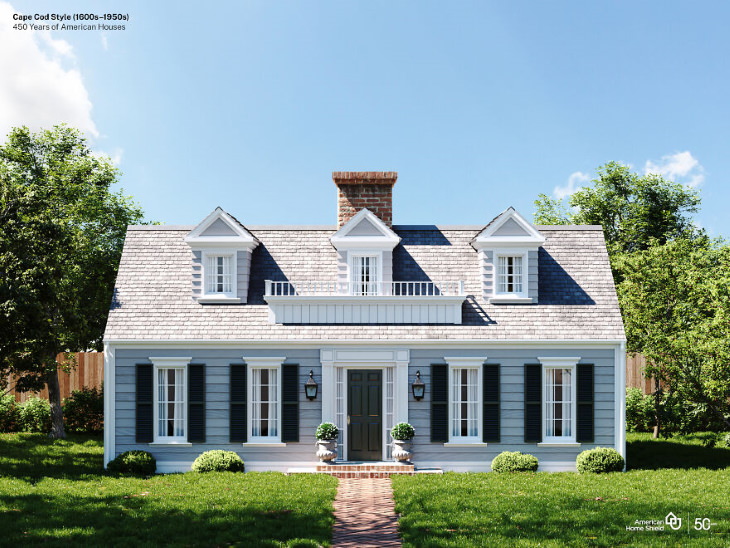
History: Cape Cod-style homes are quintessentially American. Fashion trends come and go, but these simple and classic homes continue to be popular even today. The first Cape Cod houses emerged when Puritans arrived on the coast of New England in the early 1600s and started building houses based on half-timbered English homes.
Having made a few adjustments to accommodate for the local weather, the elegant Cape Cod-style home was born. Cape Cod homes were not particularly widespread in the Victorian era, but their popularity peaked again at the beginning of the 1920s.
Key characteristics: Most Cape Cod homes are single-story or one-and-a-half-story. These homes are symmetrical and usually have a large chimney in the middle to keep the home warm in the winter. Cape Cod homes are distinguished by their elegant steep roofs, shingled exterior, and shuttered windows - all of which were added for the practical purposes of conserving heat and protecting the home and its inhabitants from the elements.
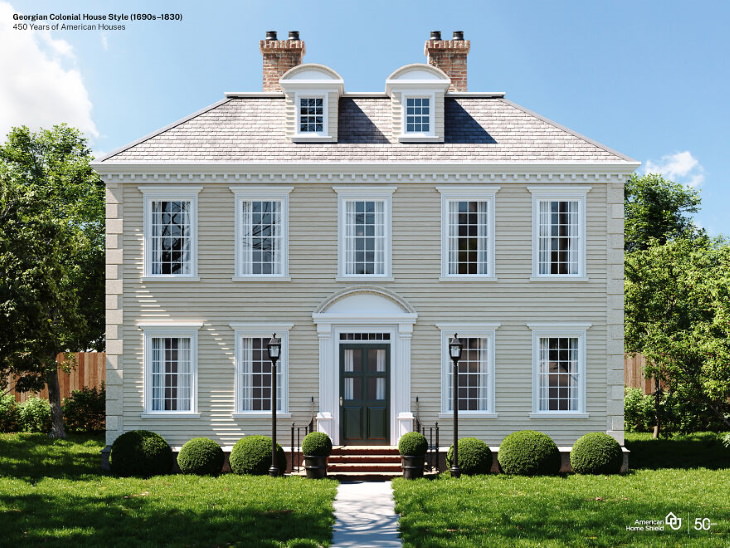
Image Source: American Home Shield
History: Named after Great Britain’s four Kings George, Georgian architecture was invented in Britain and then exported throughout the empire. Unlike Cape Cod-style homes, which were largely improvised by settlers, Georgian homes were developed by English architects Sir Christopher Wren, James Gibbs, and Inigo Jones, and arrived in America through building manuals known as ‘pattern books.’
This transition to traditional and formal architecture signaled America’s development and prosperity. After the American Revolution, Georgian homes largely fell out of favor, but they have experienced a revival in the early decades of the twentieth century.
Key characteristics: In the United States, Georgian homes are highly variable. For example, many Georgian houses in the South are made of wood rather than the traditional brick or stone. However, there’s one characteristic that’s central to Georgian houses - the symmetrical arrangement of doors and windows on the building’s facade.
This focus on symmetry and proportion is a nod to the original inspiration of Georgian architecture, which was the classical architecture of Ancient Greece and Rome, as well as Renaissance architecture. This is also why many Georgian homes feature pediments supported by columns or pilasters, particularly at the entrance.
Related Article: 500 Years of Living Room Design in 12 Pictures
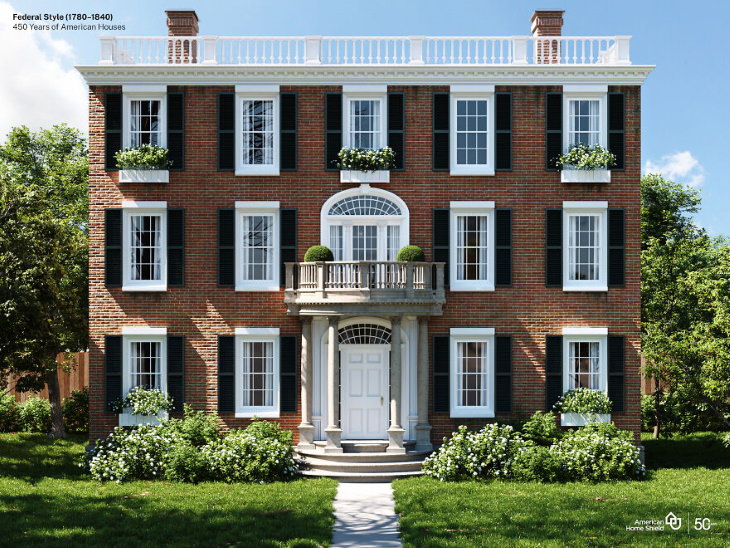
Image Source: American Home Shield
History: The Revolution urged Americans to develop their own cultural identity, and Federal-style buildings are the first attempt to do so. All buildings constructed after 1783 and until 1820 fall under this style, which is also known under the names Neo-Classical or Adamesque.
The White House and Monticello are the most prominent examples of Federal architecture, and both Thomas Jefferson and Benjamin Latrobe (the architect who designed the United States Capitol) had a big influence in the development of the Federal style.
Key characteristics: In truth, Federal architecture isn’t vastly different from the European architecture of the time. After all, it too had been heavily inspired by Ancient Roman architecture. Compared to Georgian buildings, Federal-style homes have a flatter and smoother facade, and instead of pilasters, the facade is adorned by friezes, panels, and tablets.
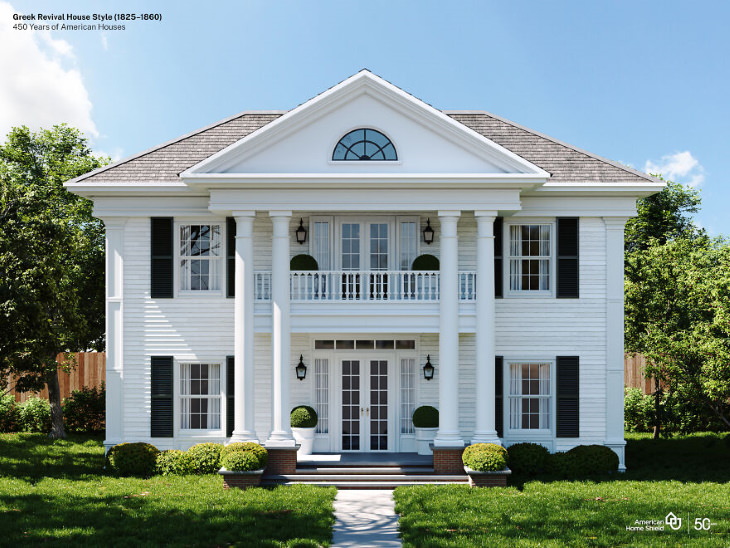
Image Source: American Home Shield
History: The invention of the Greek Revival style is usually credited to the British architect James “Athenian” Stuart, but it was the United States who fully embraced and developed this style. Since the US Constitution and the organization of the country were both inspired by Greek democracy, this infatuation with Ancient Greece also had carried over to 19th-century architecture.
One of the first large-scale examples of Greek Revival buildings in the USA is the Second Bank of the United States in Philadelphia. One of the most famous buildings that illustrate this style is the Lincoln Memorial.
Key characteristics: Columned square buildings with elements of white marble can help you easily distinguish a Greek Revival-style house. Although we know today that the Ancient Greeks painted their white marble buildings and even statues in bright colors, people had no idea that this was the case in the 19th century. The white marbled look of the Greek Revival style reflects this common misconception.
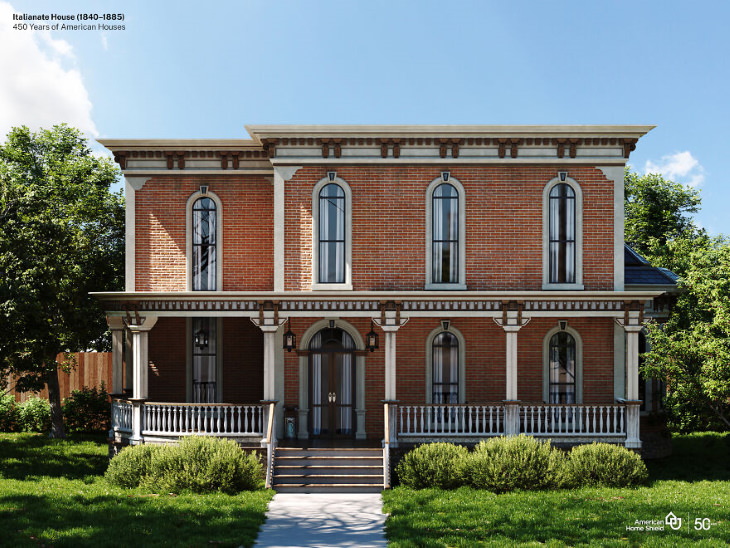
History: The Italianate Style evolved and existed simultaneously with the Greek Revival style in the United States. Better known as the Italian or Tuscan Villa style, it is derived from Italian farmhouses. American architect Alexander Jackson Davis introduced Italianate architecture in the country. One of his own designs, a villa called Blandwood created for North Carolina Governor John Motley Morehead in 1844, survives to this day.
Key characteristics: Italianate buildings were extremely popular due to their ability to accommodate cheaper building materials and the inclusion of more informal details compared to Greek Revival or Gothic Revival buildings. Towers and low-pitched or even flat roofs are both hallmarks of this style.
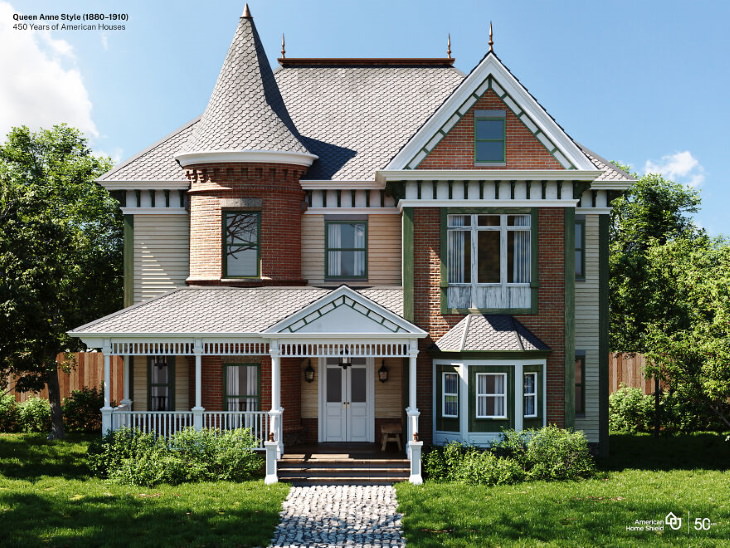
History: By the end of the 19th century and the beginning of the 20th, the Queen Anne-style home started to dominate the American cityscape. The style is an amalgamation of Victorian and Romantic-era architecture that peaked the fancy of the American elite who wished to express their wealth through an elaborate looking and richly-decorated home.
Fun fact: The Queen who is alluded to in the name was the British monarch who reigned over England, Scotland, and Ireland from 1702 to 1714.
Key characteristics: The design of a Queen Anne home is the embodiment of the “more is more” idea. Symmetry and proportion are sacrificed for the sake of a round or square tower with a cone-shaped roof at the facade and a massive front porch. Minimal elements of stone are replaced with excessive decorations both indoors and outdoors, such as monumental chimneys, painted balustrades, and decorative wood trim.
Related Article: The Evolution of Kitchen Design Over 500 Years
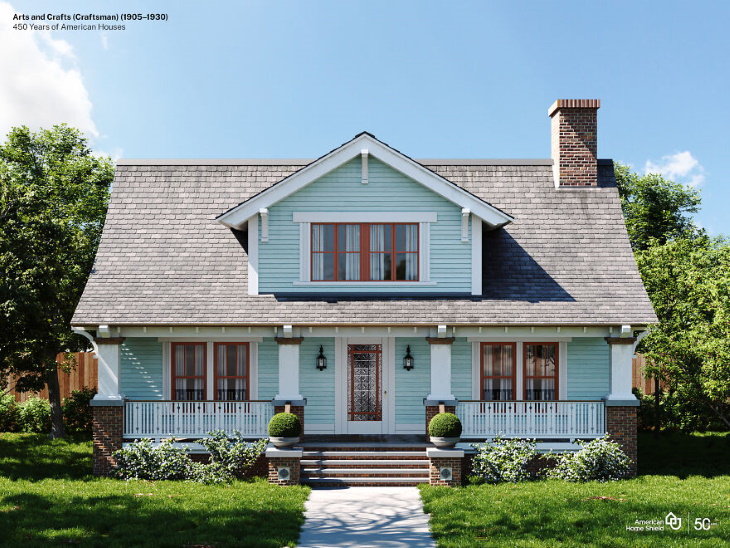
History: At the beginning of the 20th century, people had had enough of the opulence of Victorian-era architecture. The reaction was the Arts and Crafts movement, which focused on simple, hand-crafted, and accessible materials and a quality-over-quantity approach to architecture, art, design, and style.
In architecture, this meant opting for small Bungalow-style homes that allowed everyone, even working-class families, to build their own high-quality and functional homes.
Key characteristics: Compared to the intricate and, frankly, expensive homes of the previous century that could only be built by an army of skilled builders and architects, Arts and Crafts homes were simple and focused on displaying the beauty of natural materials like brick, tile, and stone. Simple and solid shapes, practical steep roofs, spacious wooden porches, and brick fireplaces are all features you’ll find in an Arts and Crafts-era bungalow.
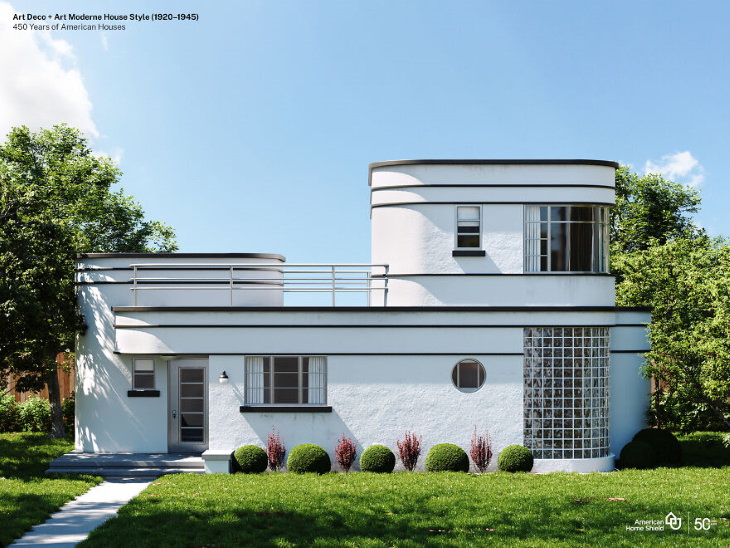
History: In the 1920s, 30s, and 40s, the Art Nouveau and Art Deco movements swept through the world. In terms of architecture, in particular, this movement focused on further simplifying the structure of buildings. At the same time, Art Deco architects incorporated decorative elements inspired by nature and human forms.
Even though we usually associate Art Deco with non-residential buildings like early skyscrapers in New York City such as The American Radiator Building or the General Electric Building, a handful of homes in this style can be found in New York City, Miami, Cincinnati, and other cities in the US. We have a whole article on this type of architecture here - 15 of the Most Beautiful Buildings in Art Nouveau Style.
Key characteristics: Unlike office buildings, airports, and movie theaters completed in the Art Deco style, residential homes in the United States that belong to this style tend to be simple and have clean lines and rectangular forms. Reinforced concrete and the use of metal and glass decorations on the facade are also common - as can be seen in the illustration above.
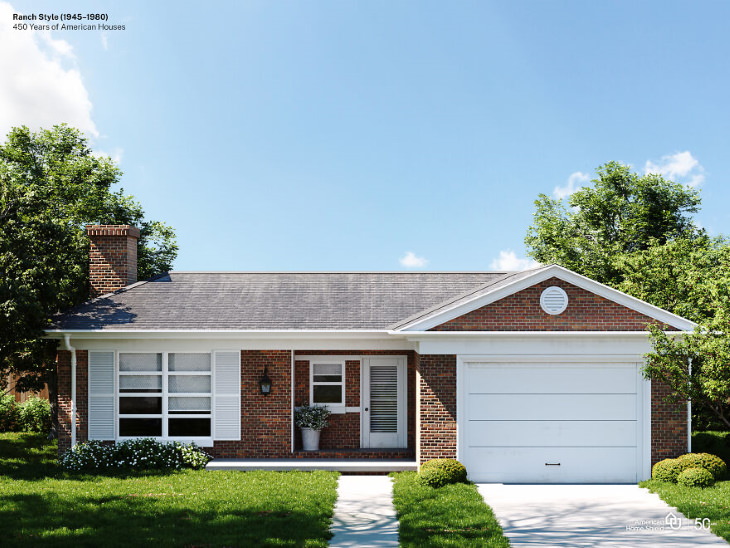
History: Chances are, you pass by dozens of homes that look like this every time you venture outdoors. The California ranch-style is actually an American adaptation of Spanish colonial ranches - low one-story houses built to withstand the heat and wind.
In the American Southwest, there were plenty of such homes, and when they were combined with the simplicity of Arts and Crafts homes and the novel materials of the 20th century, the suburban ranch-style home was born. With the expansion of American suburbs, millions of these homes were built after World War II and all the way through the 1970s.
Key characteristics: Compared to older buildings, ranch-style homes have a simple floorplan and are quicker to build, and this is their main advantage. Low-pitched gable roofs, the absence of decoration, and a built-in garage are all features you will find on most ranch-style houses.
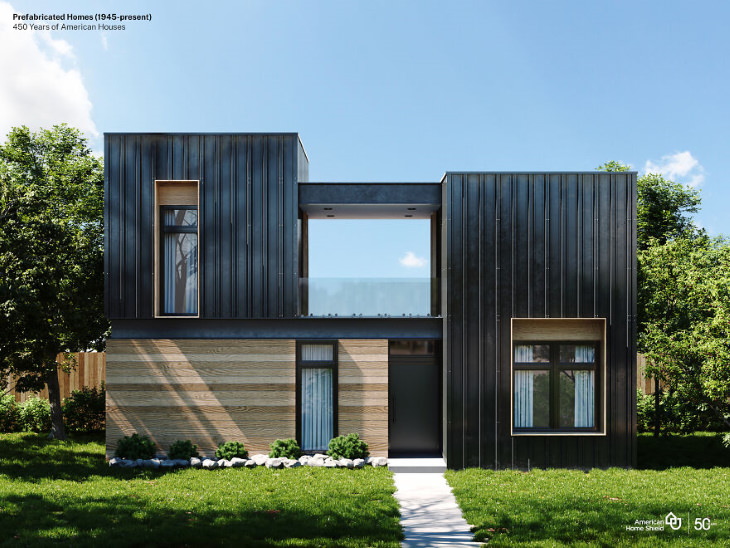
History: Ranch-style homes weren’t the only type of residential home that attempted to meet the ever-expanding demand for affordable housing. Modular homes, also known as prefabricated homes, appeared after World War II. It was an answer to an emerging post-war housing crisis, as modular buildings were almost as easy to assemble as lego and offered affordable housing. Standardized parts of modular homes are manufactured in a factory and are easily shipped across the country to be assembled on site. Mobile homes and trailers also fit within this category.
Key characteristics: Needless to say, the key feature of these homes is their simplicity. Modular homes must be easy-to-transport, which means no frills. Prefabricated homes also often feature lightweight but durable materials like sheet metal, steel frames, and wood panels.
Share this information with everyone who likes design and architecture!